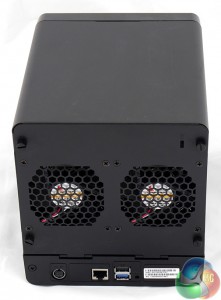
Most of the interesting stuff is on the back of the DS414j, although that may not be immediately apparent. The power jack is there and so are the two 80mm fans, along with the Gigabit Ethernet port.
This is interesting in the sense that the budget DS414j only has one network connection whereas the DS414 has two that can be joined using link aggregation. This allows Synology to claim upload and download speeds for the DS414 (135.6MBps and 207.1MBps respectively) that are almost double those of the DS414j (80.4MBps and 112.3MBps).
The aspect that I understand least about the DS414j is the inclusion of a single USB 3.0 port alongside a USB 2.0 port. Both ports are on the rear of the NAS, which is a shame as a front mounted port would be more convenient. You only get one USB 3.0 port to save on costs.
I don't know the difference in price between USB 2.0 and USB 3.0 but I struggle to believe that it would cost much for a company such as Synology to make life simple and supply two USB 3.0 ports, ideally one at the front and one at the rear.
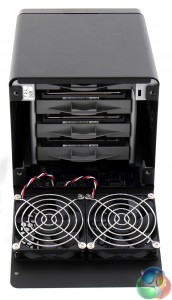
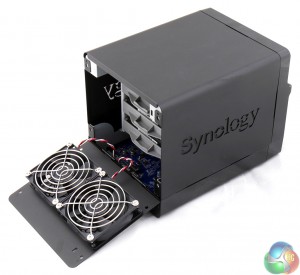
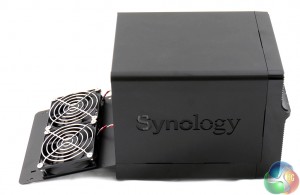
The other point to note about the rear of the DS414j are those four thumbscrews. Remove them and the back of the NAS drops down to reveal the four drive caddies.
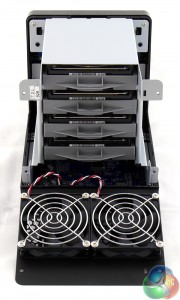
At this point you can lift away the main cover to give full access to the drive caddies.
This is a completely different operation to popping the front off the DS414 which is significant as the more expensive NAS supports hot swap drives while the DS414j does not.
This gives me pause for thought as I can see two reasons for buying a four bay NAS rather than a cheaper two bay. The first is that you want loads of hard drive capacity, perhaps in a number of volumes, in which case hot swap isn't necessarily a big deal.
For me, however, the main reason for using a four bay NAS is so you can use RAID 5 with the option of replacing a failed drive without any interruption to your network. I can see this is a dividing line for potential customers and I wish that the Synology specification included a big red X next to ‘Hot Swappable Drive' rather than a discreet dash.
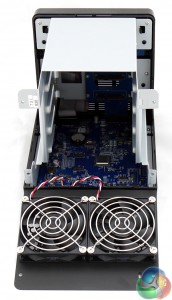
With the caddies removed from the DS414j you are pretty much left with a small motherboard sitting inside a basic steel box.
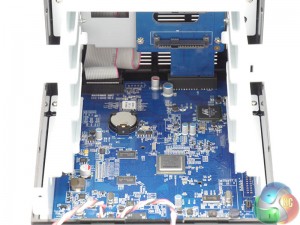
This takes us to the heart of the matter which is the Mindspeed Comcerto processor. This is a dual core ARM processor that runs at 1.2GHz. I have seen Marvell ARM processors inside Synology NAS on a number of occasions but Mindspeed was a new one on me.
A small amount of research shows that Mindspeed was recently bought by Freescale which, together with Synology's expertise in the field, gives me every confidence in the hardware.
I assume that Synology chose the 1.2GHz Mindspeed in DS414j in place of the 1.33GHz Marvell in the DS414 to cut costs. To my way of thinking it should be a relatively simple matter to replace one ARM chip with another as they use a common architecture.
I suspect that a good deal of R&D actually goes on behind the scenes. When I received the DS414 I was given a link to download DSM 5 and a second link to download a number of software packages (AudioStation, iTunesServer, SurveillanceStation and others) to deliver the full set of features for the DS414j. These software packages came in a folder named ‘Comcerto multimedia' which suggests they were compiled for this family of processors. That's just a side note as the process is entirely transparent to the end user.
The specification of the DS414j mentions support for the latest 5TB Seagate drives which means this NAS should support 20TB (unformatted) in JBOD. If you use RAID the capacity is lower as you effectively lose one or two drives.
I asked Synology why the DS414j specification puts a limit on each volume of 16TB and was told “That’s a limitation of the processor, not the DSM. Basically it means that each volume can only be a maximum of 16TB but if you have a 20TB HDD then you can just split the volume into 2 so 2 x 10TB or 16TB and 4TB.”
Or indeed you can use RAID 5. This limitation has no practical impact for the time being but when we have 6TB or 8TB drives on sale it might be something you need to check.
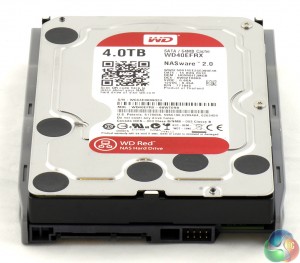
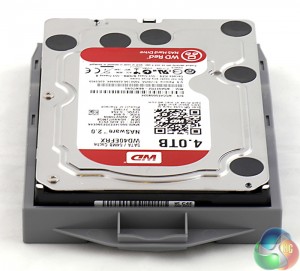
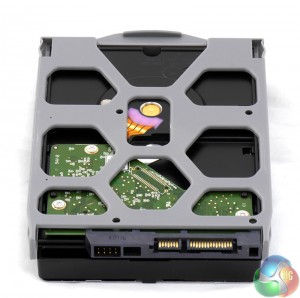
Installing the drives in their caddies is a simple matter of running four screws into the sides in the usual way. If you are using 2.5-inch HDD or SSD the screws go in the underside, just as you would expect.
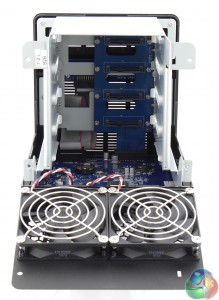
Looking inside the chassis you can see the SATA connectors at the back of the chassis although it isn't apparent these are SATA 3Gbps rather than SATA 6Gbps.
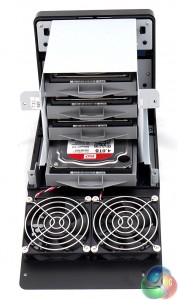
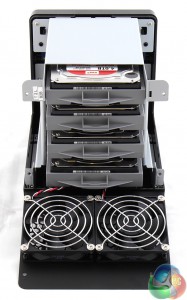
With the drives installed in their caddies you simply slide them into place.
 KitGuru KitGuru.net – Tech News | Hardware News | Hardware Reviews | IOS | Mobile | Gaming | Graphics Cards
KitGuru KitGuru.net – Tech News | Hardware News | Hardware Reviews | IOS | Mobile | Gaming | Graphics Cards


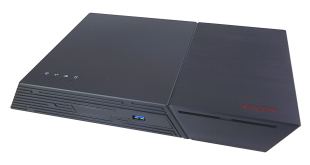
Thanks for the review!
However, according to their product page (http://www.synology.com/en-global/products/spec/DS414j) it actually is SATA 3 (6Gbit/s).
You test nas from dsm web? Why not samba? Web transfer speeds are obviously lower…